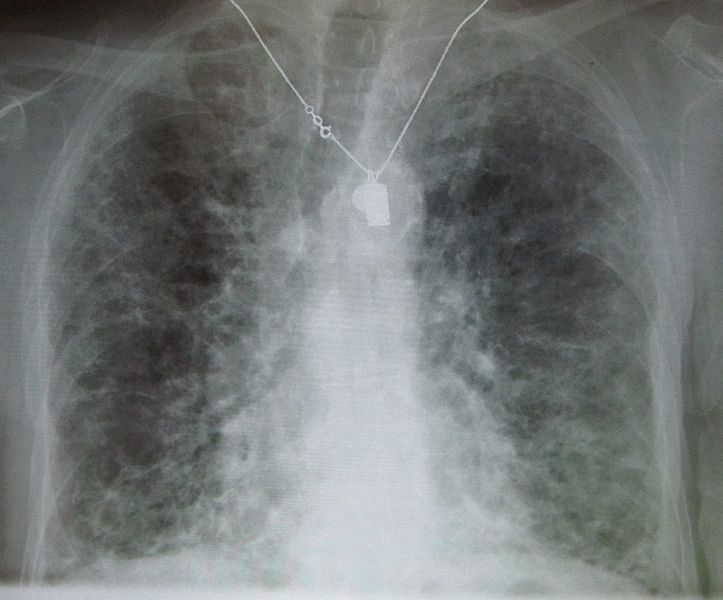Amiodarone pulmonary toxicity: Difference between revisions
Hardik Patel (talk | contribs) No edit summary |
Hardik Patel (talk | contribs) |
||
| Line 15: | Line 15: | ||
====Chronic Pulmonary Toxicity==== | ====Chronic Pulmonary Toxicity==== | ||
*Chronic interstitial pneumonitis: | *Chronic interstitial pneumonitis: | ||
The most common presentation of amiodarone-induced pulmonary toxicity is the [[ | The most common presentation of amiodarone-induced pulmonary toxicity is the chronic interstitial [[pneumonitis]]. It has an insidious and gradual onset. It is characterized by the slowly progressing [[dyspnea]], [[cough]], weight loss, and easy [[fatigue]]. These symptoms are easy to mistaken for heart disease or the effects of aging, as many patients taking amiodarone have a history of heart disease. | ||
[[Image:IPF amiodarone.JPG|thumb|none|[[Pulmonary fibrosis]] induced by amiodarone.]] | [[Image:IPF amiodarone.JPG|thumb|none|[[Pulmonary fibrosis]] induced by amiodarone.]] | ||
''Copyleft image obtained courtesy of http://en.wikipedia.org/wiki/File:IPF_amiodarone.JPG; James Heilman, MD.'' | ''Copyleft image obtained courtesy of http://en.wikipedia.org/wiki/File:IPF_amiodarone.JPG; James Heilman, MD.'' | ||
*Solitary lung mass | *Solitary lung mass | ||
===Risk Factors=== | ===Risk Factors=== | ||
Anybody taking amiodarone is at risk. People on higher doses and people who have been taking the drug for a long time appear to have a higher risk, and some evidence suggests that individuals with underlying lung disease are also more likely to have problems with amiodarone. | Anybody taking amiodarone is at risk. People on higher doses and people who have been taking the drug for a long time appear to have a higher risk, and some evidence suggests that individuals with underlying lung disease are also more likely to have problems with amiodarone. | ||
Revision as of 16:14, 19 April 2013
Editor-In-Chief: C. Michael Gibson, M.S., M.D. [1]; Associate Editor(s)-in-Chief: Hardik Patel, M.D.
Overview
Amiodarone is an antiarrhythmic drug which is commonly used to treat ventricular and supraventricular arrhythmias, in particular following pulmonary and cardiac surgery, due to a higher incidence of postoperative atrial fibrillation in these patients. It is an iodine-containing compound that tends to accumulate in several organs, including the lungs. It has been associated with a variety of adverse effects. Most individuals administered amiodarone on a chronic basis will experience at least one side effect. The most serious adverse effect is amiodarone-induced pulmonary toxicity. It occurs mostly in patients receiving large doses of the drug over prolonged periods.
Amiodarone Pulmonary Toxicity
Pulmonary toxicity is the most serious adverse effect of amiodarone, which may occur in up to 5–10% of treated patients.[1]
Types
Acute Pulmonary Toxicity
- Acute respiratory distress syndrome
Intermediate Pulmonary Toxicity
- Diffuse alveolar hemorrhage
- Pneumonia
Chronic Pulmonary Toxicity
- Chronic interstitial pneumonitis:
The most common presentation of amiodarone-induced pulmonary toxicity is the chronic interstitial pneumonitis. It has an insidious and gradual onset. It is characterized by the slowly progressing dyspnea, cough, weight loss, and easy fatigue. These symptoms are easy to mistaken for heart disease or the effects of aging, as many patients taking amiodarone have a history of heart disease.

Copyleft image obtained courtesy of http://en.wikipedia.org/wiki/File:IPF_amiodarone.JPG; James Heilman, MD.
- Solitary lung mass
Risk Factors
Anybody taking amiodarone is at risk. People on higher doses and people who have been taking the drug for a long time appear to have a higher risk, and some evidence suggests that individuals with underlying lung disease are also more likely to have problems with amiodarone.
- High cumulative dose (more than 400 milligrams per day)
- Duration over two months
- Increased age
- Preexisting pulmonary disease
Some individuals were noted to develop pulmonary fibrosis after a week of treatment, while others did not develop it after years of continuous use. Common practice is to avoid the drug if possible in individuals with decreased lung function.
References
- ↑ Martin WJ, Rosenow EC (1988). "Amiodarone pulmonary toxicity. Recognition and pathogenesis (Part I)". Chest. 93 (5): 1067–75. PMID 3282816.